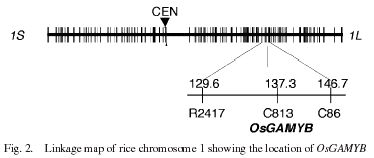|
Gibberellins (GAs) are growth factors with tetracyclic diterpenoid structure
that are essential regulators of diverse growth and developmental processes
in plant (Davis 1995). To date a series of genes encoding the enzymes
involved in GA biosynthetic pathway has been cloned from a variety of
species; a nearly complete picture of the GA biosynthetic pathway has
been revealed (Hedden and Phillips 2000). In contrast to the rapid progress
in GA biosynthesis, there is less information on how plants perceive GA
and how GA signal is transmitted, for plant growth.
GAMYB has been identified as a positive regulator for a-amylase
expression in barley aleurone cells (Gubler et al. 1995). The protein
can induce the expression of Alpha-amylase gene and other GA-inducible
genes by interacting with GA-response cis-acting elements of these
genes in the aleurone tissue (Gubler et al. 1999). Recent studies
showed that GAMYB is not only involved in GA-signaling in cereal
aleurone cells but also in other GA-regulated events, such as floral initiation
and development (King et al. 2001). However, there is no genetic
approach to characterize the molecular function of GAMYB in this context.
GAMYB in rice (OsGAMYB) has been isolated and briefly characterized
by Gubler et al. (1997). Using the reported sequence of OsGAMYB,
we examined the expression of OsGAMYB in various rice organs by
RNA gel blot analysis, to confirm that GAMYB functions not only in germinating
seeds but also in other tissues and organs after germination (Fig. 1).
The result showed that OsGAMYB was expressed at a high level in
the endosperm, embryo and other organs and tissues, such as shoot apices
and node. This indicates that OsGAMYB may function as a transducer
of GA-signal not only in aleurone cells but also in shoot apices and node.
To determine the map position of OsGAMYB, we looked for nucleotide
polymorphism between japonica rice Nipponbare and indica
rice Kasalath. We found a single nucleotide polymorphism (SNP) between
these cultivars and performed linkage analysis using 98 backcross inbred
lines (BILs) derived from Nipponbare and Kasalath (seeds given by Dr.
Yano, NIAR). Results showed that OsGAMYB locus was mapped between
R2417 and C86, on the middle of the long arm of chromosome 1 and tightly
linked with C813 (Fig. 2). We searched for GA-related mutations already
mapped around this region, but could not find one. This indicates that
the loss-of-function mutant of OsGAMYB has not been described yet,
or it may show no phenotype. We suspected that rice has another gene homologous
to OsGAMYB. The second gene may function as a redundant manner
of OsGAMYB. To evaluate this, we searched


for a gene homologous to GAMYB in the available data base but
could not find any genes encoding the conserved regions, from various
plant species, except OsGAMYB. This strongly suggests that OsGAMYB
is the only GA-related MYB gene in rice. We are currently producing
transgenic plants carrying antisense or RNAi construct of OsGAMYB,
to examine its biological function in shoot apices. These plants will
provide information on the function of OsGAMYB.
References
Davies P.J, Physiology, Biochemistry and Molecular Biology. Dordrecht,
The Netherlands: Kluwer, 1995. 833 pp.
Gubler F., R. Kalla, J. K. Roberts and J. V. Jacobsen, 1995. Gibberellin-regulated
expression of a myb gene in barley aleurone cells: Evidence of myb
transactivation of a high-pl alpha-amylase gene promoter. Plant Cell.
7: 1879-1891.
Gubler F., D. Raventos, M. Keys, R. M. Watts and J. V. Jacobsen, 1999.
Target genes and regulatory domains of the GAMYB transcriptional activator
in cereal aleurone. Plant Journal. 17: 1-9.
Gubler F., R. J. Watts, R. Kalla, P. Matthews, M. Keys and J. V. Jacobsen,
1997. Cloning of a rice cDNA encoding a transcription factor homologous
to barley GAMyb. Plant & Cell Physiology. 38: 362-365.
King R. W., T. Moritz, L. T. Evans, O. Junttila and A. J. Herlt, 2001.
Long-Day Induction of Flowering in Lolium temulentum Involves Sequential
Increases in Specific Gibberellins at the Shoot Apex. Plant Physiol. 127:
624-632.
Hedden P. and A.L. Phillips, 2000. Gibberellin metabolism: new insights
revealed by the genes. Trends Plant Sci. 5: 523-530.
|